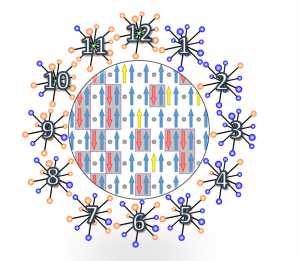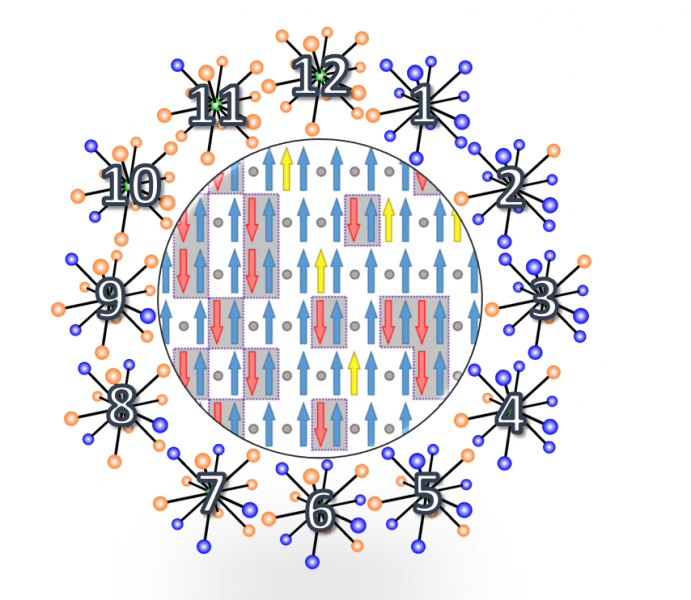Karol Załęski, Marcus Ekholm, Björn Alling, Igor A. Abrikosov, Janusz Dubowik: Local atomic configuration approach to the nonmonotonic concentration dependence of magnetic properties of Ni2Mn1+xZ1−x (Z = In,Sn,Sb) Heusler alloys, Scripta Materialia 194 (2021) 113646 https://doi.org/10.1016/j.scriptamat.2020.113646
Since the dawn of time, "materials", i.e., various types of raw materials and minerals, have played a key role in the development of human civilization. An illustrative example of the impact and scale of their importance is, for example, the names of ages in prehistory, such as the Stone, Bronze, or Iron Ages. The use of these materials by people in a given Era decided a breakthrough in the development of humanity as a species.
The unique properties conditioning the use of given materials in the past were and still are hardness and the ability to process them. Initially, they were used to produce tools necessary for survival. However, they are currently the foundation of the material world around us, and their increasingly wider use affects the continuous improvement of comfort and quality of our lives.
At the current stage of civilization development, plastics can be placed at the forefront of critical materials, which, due to their unique plastic properties, are found in the multitude of objects that surround us and that we use daily. Another material that is not so obvious to the general public but also as common and important as plastic is silicon. The electrical properties of silicon, i.e., the so-called semiconductivity, are the basis of electronics. In the latter case, it is no longer the properties helpful in creating new objects but the material's internal physical effects that determine its functionality and wide application.
The growing demand for new materials with functional properties has led to the discovery of numerous fantastic solid-state effects. Many of them are related to the physical phenomenon of magnetism, which is based on the internal electronic structure of a given material. An example of such functional properties is the magnetic shape memory and the magnetocaloric effect, which occur in magnetic shape memory alloys (FSMA - ferromagnetic shape memory alloys) and are closely related. In both effects, the phenomenon of changing the internal crystal structure under the influence of the applied magnetic field is used. In the case of the magnetic shape memory effect, this is seen as a change in the shape or movement of the material. The magnetocaloric effect is based on a transformation occurring under the influence of a magnetic field during which a low-temperature phase with a low magnetization value transforms into a high magnetization phase with a high magnetization value. The difference in the magnetization values of the two phases is of crucial importance from the point of view of the strength of the effect.
The prominent representatives of magnetic shape memory alloys are Heusler alloys Ni2Mn1+xZ1-x, where Z = In, Sn, Sb. Heusler alloys are a broad class of materials with diverse physical properties. Depending on their composition, they can be metals, semiconductors, or semi-metals, most of which are magnetic.
As part of close cooperation, researchers from the NanoBioMedical Center of the Adam Mickiewicz University, the Institute of Molecular Physics of the Polish Academy of Sciences in Poznań and the University of Linköping (Sweden) studied the effect of changing the composition of Ni2Mn1+xZ1-x alloys (Z = In, Sn, Sb) on the magnetic properties of their high-temperature phase. Using computational methods, scientists explained the positive, negative, and non-monotonic nature of the changes in the magnetic moment observed for these alloys depending on the root substituted for 'Z'. To this end, researchers developed a model of how changes in local atomic configuration affect the total magnetic moment of the alloy. In addition, the conclusions obtained from the use of the proposed model were confirmed experimentally. To this end, scientists used the phenomenon of hysteresis loop shifting in the magnetic field, the so-called "exchange bias" effect, which confirmed the existence of areas contributing negatively to the total magnetic moment in the Ni2Mn1+xSn1-x alloy.
The application of the developed model is not limited to the alloys mentioned above but allows for the study of physical properties, especially magnetism, in materials of non-stoichiometric composition.


